When an intrepid young man flees his home to protect it from demon-like creatures, a high-fantasy tale begins that is unlike any others before it.
The young man, Frodo Baggins, has in his possession the One Ring; a powerful and corrupt piece of jewelry meant to dominate the races of Middle Earth and control the world. Throughout his story, a ragged cast of characters unites under one cause — to destroy the ring — and traverses Middle Earth to bring their goal to fruition.
While the cinematography of the trilogy of movies makes each feel like it was shot in its very own fantasy world, the sprawling settings took place on our very own, regular earth.
Learn more about where The Lord of the Rings trilogy was filmed, the best time to visit filming spots, and the flora and fauna of the setting.
Where Was The Lord of the Rings Trilogy Filmed?
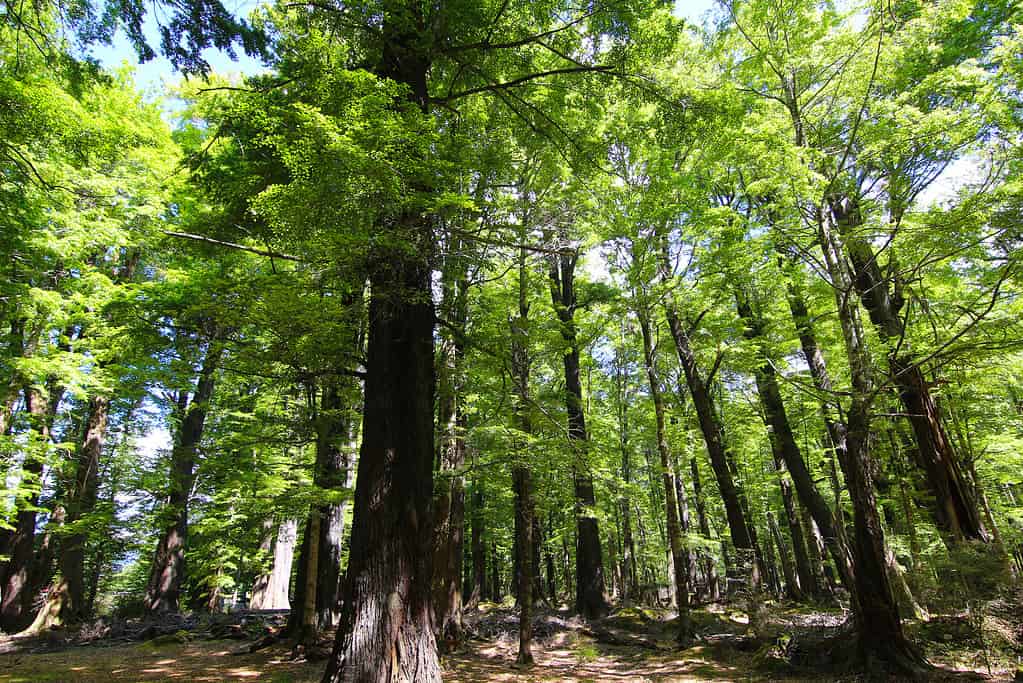
The Dart River, like many other areas in and around the Glenorchy and Queenstown area, was used for filming many scenes for
The Lord of the Ringsfilm trilogy.
©Marco Ramerini/iStock via Getty Images
Production shot every movie in the trilogy in New Zealand, though the parts of the country vary widely based on the scenes in question. The crew traveled extensively, covering over 150 locations in New Zealand across the three movies.
The Fellowship of the Ring
Filming locations for The Fellowship of the Ring traversed the country of New Zealand — ranging between Waikato in the north to the Waiau River in the southern island.
The North Island
Waikato in Matamata became known as Hobbiton — the peaceful village in which Frodo and his uncle Bilbo live. Waikato’s green rolling hills and lush landscape were perfect locations for the Shire, which J. R. R. Tolkien describes in the books as a beautiful and fruitful land far away from the troubles of the rest of the world.
If you’re on the North Island, the best place to visit is Wellington. In and around the area, the crew leveraged dozens of different sites for the movie. For example, the Town Belt of Mount Victoria held the tree that the four hobbits hid from the Black Rider. Or consider the abandoned Fort Dorset in Seatoun, where the crew built the town of Bree. Finally, Wellington’s Harcourt Park acted as the evil wizard Saruman the White’s abode — before he chopped down the forest around his tower to create the Uruk-hai.
Moving further into the country is Kaitoke Regional Park, where the movie crew erected the elvish oasis of Rivendell. This location also doubled as the “great River Anduin,” which was actually the Hutt River.
The South Island
Fiordland supplied several locations like Weathertop, where the ringwraiths catch up with the hobbits and Aragorn comes to save them. The name of the hill on which Frodo gets stabbed is Te Anau. The Arrowtown Recreational Reserve starred as several striking locations in the movie, including West Road, Region Hills, the Misty Mountain, and the Ford of Bruinen. The last scene mentioned, the Ford of Bruinen, took place on the real-life Shotover River.
If you’re looking to sail between the Argonath — the two towering statues of ancient Gondorian kings — head over to the Kawarau Gorge.
Finally, Closeburn became the ethereal Lothlorien Woods from the end of the movie, where Boromoir became fatally wounded and orcs captured Merry and Pippin. Green Stone National Park served as one of the final scenes of the movie, where Frodo and Sam trudge into the lake and escape the orcs on boats. During filming, divers scoured the bottom of the national park’s water line to make sure the actors didn’t step on anything or get hurt. Still, somehow a large piece of glass missed their analysis and Sean Astin, who played Samwise Gamgee, stepped on it — receiving a massive gash that forced him to be flown to a nearby hospital to receive stitches.
The Two Towers
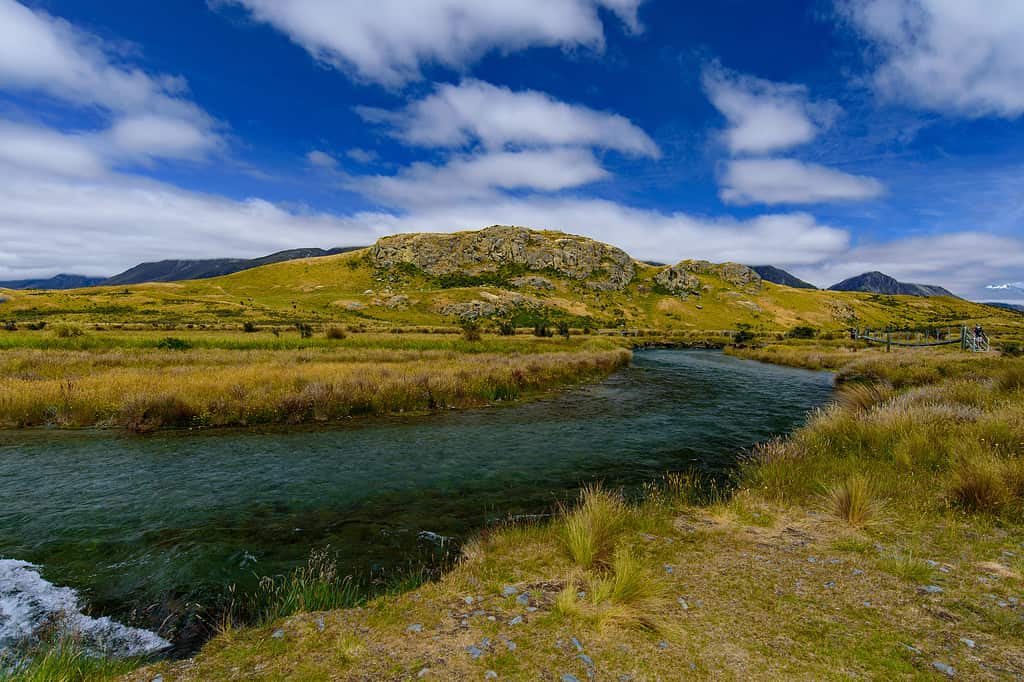
Mount Sunday became the movie set for Edoras in
The Lord of the Rings.
©momo11353/iStock via Getty Images
Similar to the first movie, the production flew across the two islands of New Zealand to capture the perfect shots. Wellington, again, became a vital location for both filming and production.
The North Island
The major fortresses of the movie — Minas Tirith and Helm’s Deep — both found their homes at Dry Creek Quarry in Wellington. Visitors can no longer see the fortresses, as the quarry remains active and resumed work after production dismantled the sets. Also in the north is Waitarere Forest, which became Osgiliath Wood in the movie — the thinning forest in which Frodo, Gollum, and Sam walk as they leave Faramir’s group.
The South Island
Unlike the first movie, southern New Zealand supplied the majority of shooting locations for the second movie. One of the most pivotal places became Ida Valley, which stood as the golden-fielded plains of Rohan. Even more iconic: Mount Sunday, on which the crew built the capital city of Rohan, Edoras.
Traveling back to the Te Anau basin, production used wide shots of the Kepler Mire for the Dead Marshes, though the actors didn’t struggle through the bog in real-time for shots (those were done on an indoor set).
Finally, the breathing, talking, and walking trees of Fangorn Forest live in Fiordland. Takaro Road near Te Anau provides sites on both sides of the road to reenact your favorite Merry, Pippin, and Treebeard moments.
The Return of the King
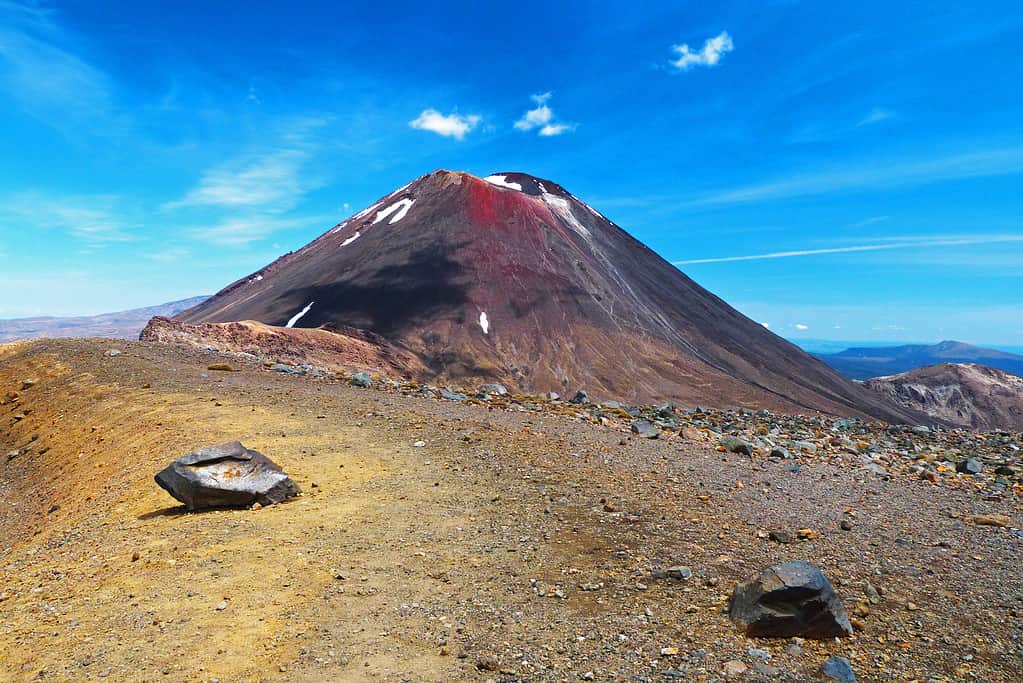
Tongariro National Park, New Zealand, holds the real-life site of Mount Doom.
©Milan Sommer/iStock via Getty Images
In the last movie of the trilogy, production continued to use several of the same locations — including Mount Sunday for Edoras, Dry Creek Quarry for Minas Tirith, and Waitarere Forest, which changed from Osgiliath Wood in the second movie to the path to the Grey Havens in the third. The epic conclusion to the trilogy also used many one-off locations, listed below.
- Mackenzie Country, Ben Ohau Station, and Queen Elizabeth Park became Pelennor Fields, where one of the most epic final battles occurred.
- Whakapapa Skifield and Tukino Skifield became the slopes of Mount Doom, which Sam heroically carried Frodo up on his back.
- Putangirua Pinnacles became the valley to Dimholt Road, where Aragorn, Legolas, and Gimli traveled to meet with the Army of the Dead.
- Crews built the Rohirrim camp at both Dunharrow Greenstone Station and Mount Victoria Quarry.
Best Time to Visit New Zealand
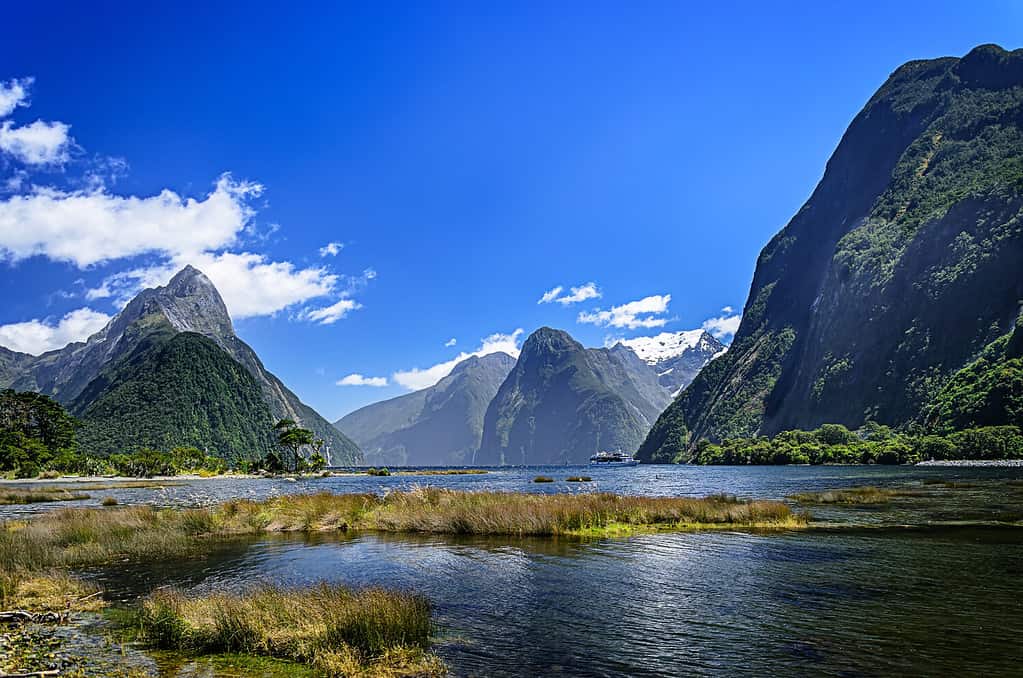
Visiting New Zealand in the “winter” months of December, January, February, and March will offer the best weather.
©Katarina S/Shutterstock.com
Located in the southern hemisphere, New Zealand’s summer season occurs between December and March. Within this time frame, the weather remains pleasant for visitors and mostly dry. Day temperatures will range between the mid-60s and 70s Fahrenheit, and the sun shines for the majority of the weeks.
If you’re looking for the cheapest time to travel to New Zealand, consider the shoulder seasons, or off-season. During June through October especially, prices remain cheaper at many accommodations besides ski resorts (because it’s their “on” season).
Lord of the Rings Movie Tours
Between the three movies, box office numbers nearly reached $4 billion. The groundbreaking movie trilogy garnered more and more fans as movies were released, reigniting a love for author J. R. R. Tolkien’s high fantasy series.
With such great box office performance for both the Lord of the Rings trilogy and the prequel movies for The Hobbit, New Zealand has created dozens of trails, tours, and virtual experiences for fans to relive the magic and mysticism of their favorite movies. Travel between Auckland and Queenstown to see filming locations like Edoras, Fangorn Forest, Hobbiton, and more. Some tours allow guests to meet crew members, get a behind-the-scenes look at Weta Workshop, and embark on nearby adventures.
Some of the places not on organized tours but still open to the public include Fernside Lodge, which houses the locations for both Lothlorien and Gladden Fields, and Hobbiton™, which is an immersive accommodation and dining experience to live in a hobbit hole and eat at the Green Dragon.
Hans Mast, a travel expert with over 15 years of experience at GoldenRule Travel, talked to A-Z Animals about three different places to visit for a unique Lord of the Rings-themed tour in New Zealand.
“Hobbiton, located in Matamata, is an iconic attraction. It’s the real-life Shire, meticulously crafted for the films,” recounted Mast. “For adventurous fans, Tongariro National Park offers the chance to hike the Tongariro Alpine Crossing. This trek leads you to the fiery Mount Doom, also known as Mount Ngauruhoe in real life.”
Mast concluded with, “In Wellington, the Weta Workshop is a must-visit. It’s the creative heart behind the film’s special effects and props. Visitors can take a guided tour to see the craftsmanship that brought Middle-earth to life.”
Flora and Fauna of New Zealand
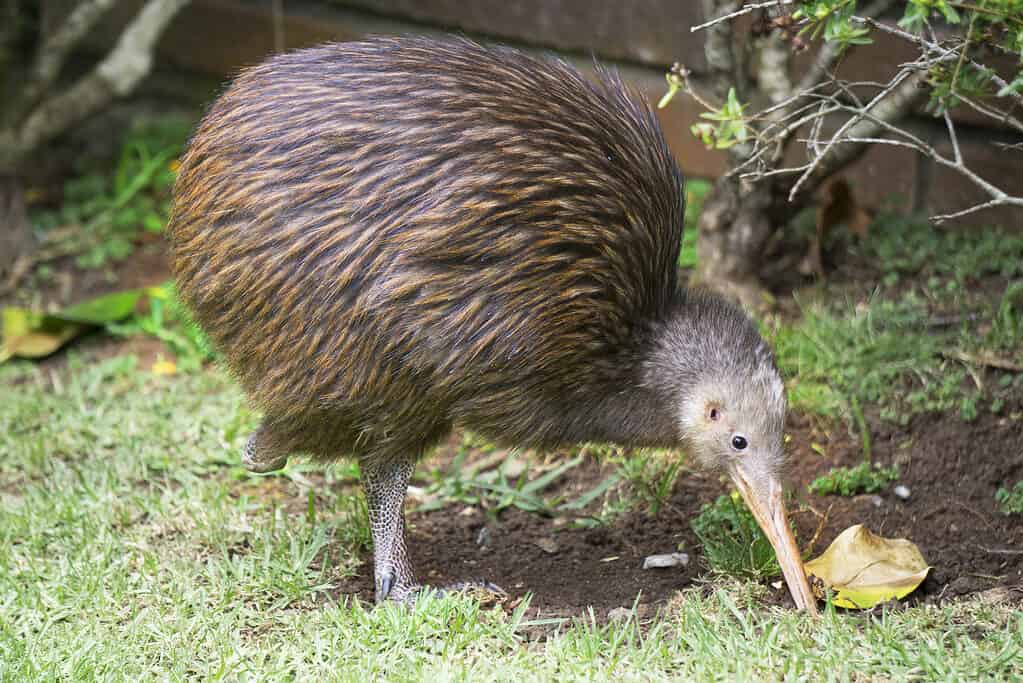
The New Zealand national bird is the kiwi.
©iStock.com/Jason Magerkorth
Unlike its often-compared-to neighbor Australia, New Zealand’s flora and fauna remain beautiful, not dangerous, and readily navigable by the most amateur adventurer.
Flora
Native flora dots the land of New Zealand, covering up to 15% of the entire country with plants like the kauri and kohekohe trees to ferns, pingao sedge, and tussock.
Trees in New Zealand can tower over the visitors below, reaching heights of over 60 feet tall. The native trees in New Zealand include five unique species of beech forests, plus cabbage trees, kauri, and kowhai trees. The only native palm tree species in New Zealand is the Nikau palm, which doubles as the southernmost member of the palm family as well. Like beech, there exist five types of podocarp hardwood trees in the country. Finally, there are three types of wetland forests in New Zealand.
Among the other plants in the country is the shrubby tororaro, which remains one of the country’s most ecologically and culturally significant shrub species. Pōhutukawa, a Christmas tree in New Zealand, holds special significance to the Maori people through their mythology. The country has unique and world-record-holding plants too, including the Mount Cook buttercup, which remains the largest buttercup in the world, and dactylanthus, the only indigenous and fully-parasitic flowering plant in New Zealand.
Fauna
The types of animals in New Zealand cover a wide range — including mammals, birds, fish, reptiles, and insects. Interestingly enough, there aren’t many snakes on land in New Zealand; instead, some swim in nearby oceans. The insects of the country vary but one in particular deserves special mention: the giant wētā. Now protected by law because they’re at risk of extinction, wētā are large cricket or grasshopper-looking animals with 11 different species.
Some of the other most common or native animals in New Zealand include:
- The kiwi bird. This flightless bird is endemic to the country of New Zealand and about the size of a standard chicken. Its long beak helps it find food and its feathers feel like fur.
- Tuatara. The lizard-like reptile is native to New Zealand and one of the largest of the family. It has a third eye on the top of its head.
- Yellow-eyed penguins. Considered one of the rarest species of penguins in the world, this flightless bird is small and on the threshold of becoming endangered because of food shortages and global warming.
- Chevron skink. While only found in certain parts of New Zealand, the endemic skink mostly lives in forests and under the water, where it hides from its main prey: rats.
- Royal albatross. Dunedin is home to the Royal Albatross Center, which offers a large sanctuary for the birds to live, reproduce, and weather in.
Shire… Baggins…
With so many different places to tour, you’ll want to take some time off between December and March to make your way over to the Land of the Long White Cloud. Become an honorary hobbit as you hike, drive, and bike your way through the most pivotal locations in Middle Earth.
The photo featured at the top of this post is © phil_ioffe/iStock via Getty Images
Thank you for reading! Have some feedback for us? Contact the AZ Animals editorial team.






